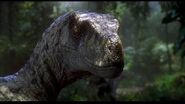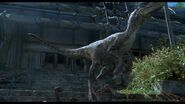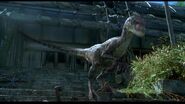Isla Sorna[]
Length: 13 feet
Height: 5.5 feet
Weight: 180 pounds
Both subspecies of Velociraptor are actually engineered from the genes of Deinonychus. Of the two subspecies bred by InGen, the Sornaensis subspecies has shown to be more vocally social than the Nublarensis Raptors, whose attack patterns are based more on body movement with some vocal interaction included. Sornaensis raptors and Nublarensis raptors seem to possess the same intellectual capabilities including setting traps, solving basic problems, and searching for ways to overcome barriers, however are more aggressive towards eachother due to the lessened social interaction between individuals. Fights or small quarrels are less common among Sornaensis raptors, as the issue is often solved vocally before it can become physical.
Click this link to read about hybrids.
Coloration:
- Male: Blue-Gray bodies with a creamy brown underbelly, brownish red backs and a light blue stripe running along each side of the body. The prominent ridges on the snouts of dominant males are red and are used for display. The backs of males' heads are lined with dark gray quills The eyes are red.
- Female: Creamy white with black blotches on their bodies. Lacking quills, yellow eyes.
- Juvenile (male): Same as adult male, without the quills and stripes.
- Juvenile (female): Same as adult, though with brown blotches instead of black.
Diet: Carnivorous, able to take mammals and small herbivores when alone and hadrosaurs when in packs.
Preferred Habitat: Wide range of habitats from jungle, grassland and wetland, even taking up residence in abandoned InGen sites.
Social Structure: Hierarchical Packs similar to that of a wolf, with an alpha male and/ or female.
Velociraptors are among the deadliest and the most intelligent of carnivorous dinosaurs cloned by InGen. Their jaws are lined with many sharp, serrated teeth and the grasping three-fingered hands are equipped with strong, sharp talons. A raptor's most infamous feature is an enlarged "killing claw" on the second toe of each hind foot, resembling a scythe. The claw is capable of being swiveled in a downward, slicing arc; an effective slashing weapon.
When hunting, Velociraptors stalk their prey slowly and patiently. One member of the pack will deliberately show itself, unnerving the victim in order to distract it from the oncoming attack from the other raptors hidden at the victims' sides and rear. A raptor's claws are used in conjunction with its teeth to rip and tear into the victim's flesh, inflicting terrible wounds from which it dies a slow, painful death through blood-loss or shock. A raptor may also employ its claws as hooks to climb up onto the bodies of large prey in order to reach the more vulnerable neck region. Sorna raptors have powerful hind legs which give them the ability to run at speeds of up to 75 miles per hour on open land and to leap incredible heights. They can also issue powerful kicks to send its killer claw slicing through their victim's belly and spilling the intestines. But if a Spinosaurus shows up and attack the pack. They will attack the sail and keep attacking until either the spinosaurus defeats the pack or the spinosaurus backs down.
Sorna raptors are generally more active during the day. They are slightly smaller and more lightweight than their Nublarensis counterparts.
Raptors care for their young together in nesting communities, in which all the adults of a pack will take turns in caring for one another's young. The chicks, while small and vulnerable, are kept in dens dug by the adults or other animals to keep them safe from large predators, and are fed on meat regurgitated by the adults. As the young grow, they begin to hunt small prey, such as lizards, mammals, and invertebrates. Both raptor subspecies will ferociously guard their nests, and packs of Sorna raptors have been known to go to great lengths to retrieve any eggs or young that have been seized by a predator.
Male Sorna raptors have hollow quills at the back of their heads and raised snout ridges which are more vibrantly coloured in dominant individuals. The quills of the males each have a tiny muscle at the base and thus are capable of independent movement.
Raptors are among the most vocal of Isla Sorna's bestiary, capable of communicating with over 2,000 different sounds including barks, hisses, chirps and screams.
For more information, see: Velociraptor "antirrhopus" (S/F)








